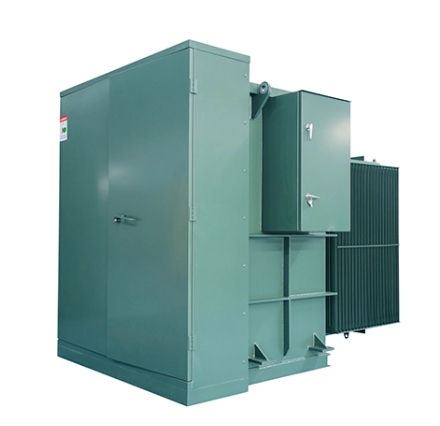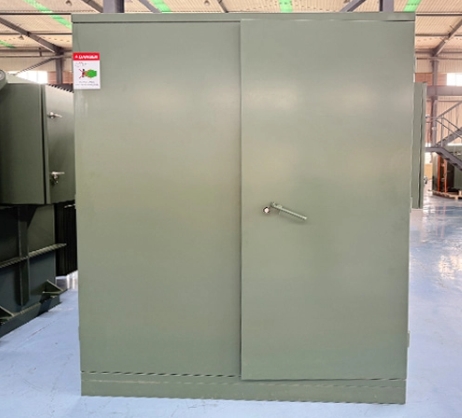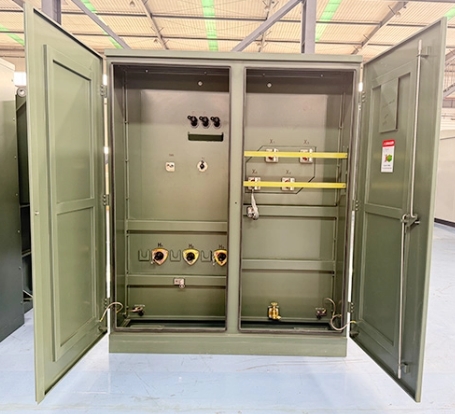

RADIAL FEED PAD MOUNTED TRANSFORMER-ZGS-1500-13.8-0.415
- Home
- Product
RADIAL FEED PAD MOUNTED TRANSFORMER-ZGS-1500-13.8-0.415
The ZGSL-Z-1500-13.8-0.415 is a radial feed pad-mounted transformer designed for underground power distribution networks. It steps down 13.8kV primary voltage to 0.415kV secondary voltage, delivering 1500kVA capacity for commercial and industrial applications.
Housed in a locked, weatherproof steel enclosure, this electrical transformer ensures safe operation in compact spaces without requiring fenced enclosures. Key features include:
- ✔ High-efficiency design (up to 98.5% energy efficiency)
- ✔ Radial feed configuration for simplified underground cable connections
- ✔ Corrosion-resistant construction for outdoor durability
Ideal for utility service drops, this pad-mounted transformer provides reliable power conversion while meeting IEEE and IEC standards.
-
Superior Cost Efficiency (vs Loop Feed)
The radial feed design reduces infrastructure costs by approximately 25% due to simpler cabling requirements. This transformer maintains 98.5% efficiency (3.2kW no-load / 18.5kW load losses), verified by ISO 9001-certified testing. -
Compact & Space-Saving Design
With dimensions of just 2.1×1.8×1.9m, this pad mounted transformer is ideal for space-constrained sites. The radial configuration eliminates complex switching gear, saving up to 35% footprint compared to loop feed alternatives. -
Reliability and Durability
Built to withstand harsh environmental conditions, the transformer features a robust design for long service life. It resists weather, vandalism, and wildlife interference, ensuring consistent and reliable power distribution. -
Ease of Installation and Maintenance
Ground-level placement simplifies installation, requiring only a concrete pad and electrical connections. This accessibility also makes routine maintenance and inspections more straightforward, reducing operational costs and downtime. -
Enhanced Security
Lockable enclosures provide an additional layer of security, protecting against unauthorized access and tampering. This is especially important in areas susceptible to vandalism or where public safety is a concern.
| Type | Pad mounted transformer-Radial feed |
|---|---|
| Model | ZGS-Z-1500/13.8-0415 |
| Installation | Outdoor |
| Altitude | ≤1000m |
| Rated Power | 1500KVA |
| Cooling Method | KNAN |
| Primary Voltage | 13.8kV |
| Secondary Voltage | 415Y/240V |
| Rated Frequence | 60HZ |
| Insulation oil | FR3 |
| Tapping Range | ±2×2.5% |
| Temperature rise(℃) | 65 |
| Connection Group | Dyn1 |
| Impendace % | 5-7.5% |
| Dimensions(mm) | 1900*2640*2150 |
| Total weight(kg) | 8030 |
- Residential Subdivisions: Ideal for housing developments with single-source power feeds.
- Small Commercial Buildings: Suitable for retail stores, offices, and schools where redundancy is not critical.
- Rural Electrification: Used in remote areas with simple grid layouts.
- Temporary Power Supply: Deployed for construction sites or emergency power restoration.
- ✔ Lower Installation Cost (25-30% savings vs. loop feed)
- ✔ Simpler Design (Single power input reduces cabling complexity)
- ✔ Faster Commissioning (Can be installed in 6-8 hours)
- ✔ Easier Maintenance (Fewer components to inspect)
- Urban Grids & Smart Cities: Used in networked distribution systems requiring high reliability.
- Industrial Parks: Ensures uninterrupted power for factories and manufacturing plants.
- Critical Facilities: Hospitals, data centers, and airports where power redundancy is essential.
- Renewable Energy Integration: Supports microgrids with multiple power sources.
- ✔ Need automatic backup power (N-1 redundancy)
- ✔ Require minimal downtime during maintenance
- ✔ Operating in high-load, complex grids
- Cost-Effective
Saves ¥15,000–20,000 per unit in cable and switching gear costs. - Space-Saving
30% smaller footprint than loop feed, ideal for tight urban spaces. - Lower Maintenance
50% fewer inspection points, reducing long-term servicing costs. - Faster Deployment
Plug-and-play design enables quick installation in under 8 hours.
1. Shipment, Handling, Rigging & Storage
- Inspect the transformer for shipping damage upon arrival. Report any issues to the carrier immediately.
- Use only designated lifting lugs and appropriate rigging equipment rated for the transformer’s weight. Never lift by bushings or radiators.
- Store the transformer upright on a level, dry surface. Protect from weather and flooding. For long-term storage, seal all openings and monitor silica gel breathers.
2. Transformer Installation
- Crane Lifting & Rigging: Attach slings to marked lifting points. Use spreader bars if needed to avoid tank deformation.
- Jack & Skid: For short moves, use jacks and skids under the base. Move slowly and avoid sudden movements.
- Foundation: Place transformer on a flat, solid, non-combustible pad with proper drainage. Anchor as required by local codes.
- Compartment: Ensure HV and LV compartments are accessible and free of debris. Check gasket seals for integrity.
- Grounding: Connect tank and neutral points to a reliable earth ground per IEEE/NEC standards.
- High Voltage & Low Voltage Connections: Clean and torque all cable terminations to manufacturer’s specifications. Use proper lugs and insulation.
- Dielectric Fluid: Check oil level and top up with approved fluid if necessary. Sample oil for moisture and dielectric strength if required.
- Transformer Pressure: Verify pressure relief device is operational. Check for correct internal pressure or vacuum as specified.
- Other Aspects: Install required signage and barriers. Confirm all accessories are installed and functional.
3. Pre-Energization
- Perform insulation resistance and turns ratio tests. Confirm all connections are tight and correct.
- Verify tap changer is set to the correct position.
- Check oil level, absence of leaks, and operation of gauges and alarms.
4. Post-Energization
- Monitor for abnormal noise, vibration, or temperature rise.
- Check for oil leaks and monitor gauges for pressure and temperature.
- Record initial load and voltage readings.
5. Switching Operation
- Operate switches only under no-load conditions unless rated for load-break.
- Follow lockout/tagout procedures before maintenance.
- Use insulated tools and wear appropriate PPE.
6. Protection
- Ensure fuses, surge arresters, and relays are installed and rated correctly.
- Test protection devices per manufacturer’s recommendations.
7. Accessories
- Check operation of temperature gauges, pressure relief devices, oil level indicators, and gas relays.
- Maintain and calibrate accessories as required.
8. Maintenance
- Perform periodic inspections for leaks, corrosion, and proper operation of all devices.
- Sample and test dielectric fluid annually or as recommended.
- Clean bushings and compartments regularly.
9. Field Acceptance Test Guidelines
- Conduct insulation resistance, turns ratio, and winding resistance tests before energization.
- Compare results with factory test reports and standards (e.g., IEEE C57.12).
- Document all test results for future reference.
10. Tables and Procedures
- Refer to the manufacturer’s manual for torque values, oil specifications, and test limits.
- Maintain a log of all inspections, tests, and maintenance activities.
- Follow standard operating procedures for all field operations.
RELATED PRODUCTS






